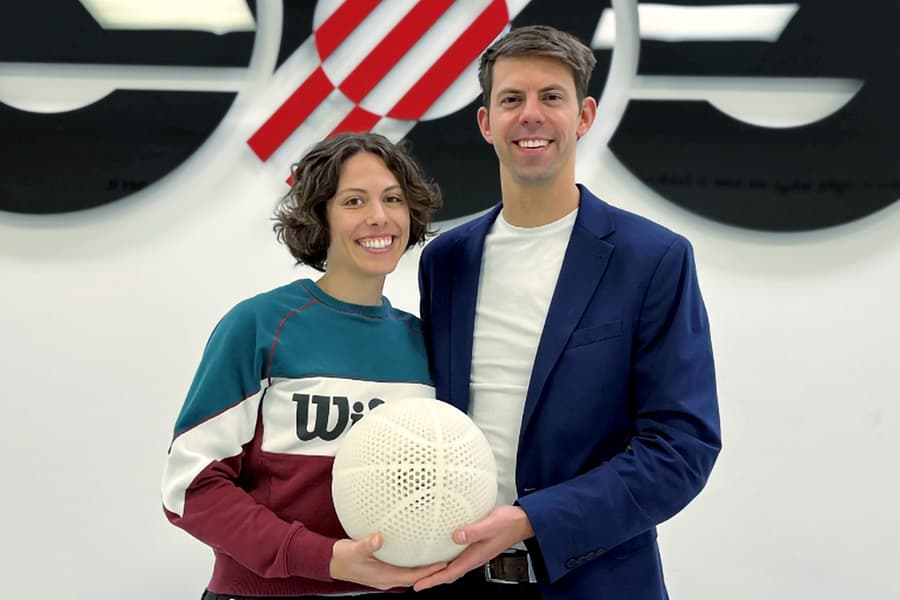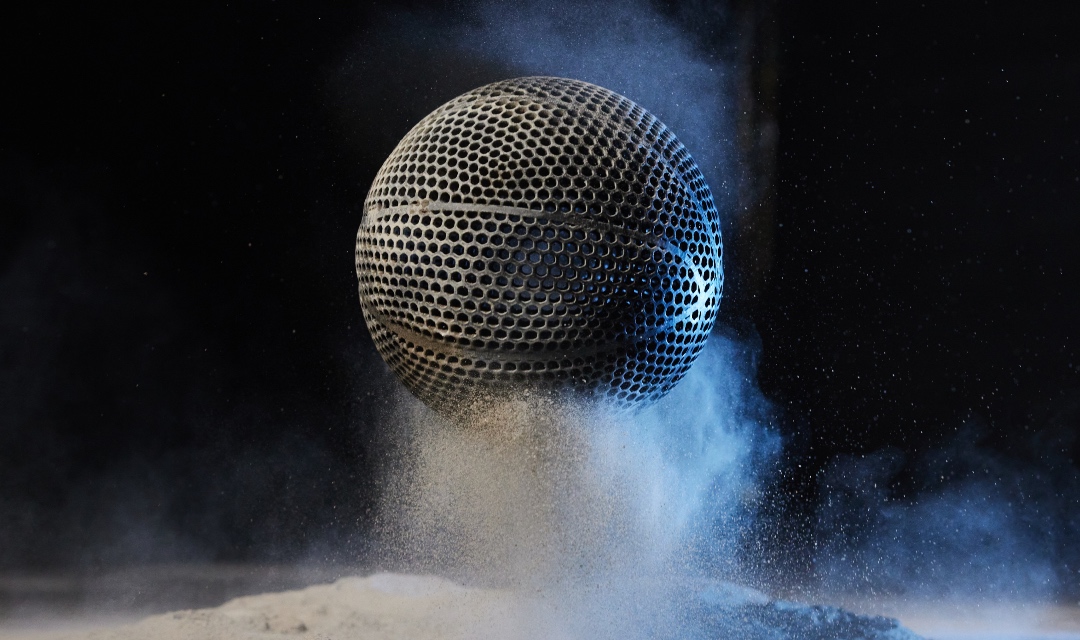
Scoring Big
CMU alumni Nadine Lippa and Dave Krzeminski are teaming up to change the future of sports
By Monica Cooney
One of the most common complaints among consumers who purchase and use inflatable balls is that they inevitably go flat. An airless solution to remedy this issue in basketballs is in progress with a pair Carnegie Mellon University materials science and biomedical engineering alumni at the forefront of its development.
As students, College of Engineering alumni Nadine Lippa and Dave Krzeminski relied on their interest in sports to keep them balanced as they pursued their degrees.
Class of 2008 graduate Nadine spent a year on the women’s soccer team as a walk-on, was a buggy pusher for PIKA for four years and took up trail running and yoga. Class of 2007 graduate Dave was a member of the men’s swimming team, capturing the NCAA title for the 200 butterfly in 2007.
Though their time as students overlapped, it wasn’t until after they had graduated that they were able to connect thanks to Michael McHenry, professor of materials science and engineering in the College of Engineering. Nadine saw McHenry during Spring Carnival after she had graduated and inquired if he knew of anyone working in sports materials engineering.
“The combination of MSE (materials science engineering) and BME (biomedical engineering) really set the stage to go into sports engineering,” Nadine says. “The electives that fell between those two majors, such as studying physiology with Dr. Phil Campbell, along with my MSE base, made me well-rounded going into my career.”
McHenry introduced Nadine to Dave, who was completing his Ph.D. at the University of Southern Mississippi at the time. Nadine and Dave quickly became acquainted and continued to connect sports to their work. They followed similar trajectories in their doctoral programs, international internships and fellowships; published research; and were married in 2017.
 They collaborated on a prototype of Wilson’s 3D printed basketball that debuted at 2023’s NBA Slam Dunk Contest during All-Star Weekend. Nadine, who is an innovation manager at Wilson Sporting Goods, says the project initially launched in 2018 in response to three issues faced by Wilson and its consumers: consistency in play that is impacted by ball inflation, sustainability and production limitations.
They collaborated on a prototype of Wilson’s 3D printed basketball that debuted at 2023’s NBA Slam Dunk Contest during All-Star Weekend. Nadine, who is an innovation manager at Wilson Sporting Goods, says the project initially launched in 2018 in response to three issues faced by Wilson and its consumers: consistency in play that is impacted by ball inflation, sustainability and production limitations.
From a sustainability perspective, an airless basketball has many benefits. There is less waste with its production via additive manufacturing as only one material is used to create this ball opposed to many materials procured globally in a conventional basketball. Its ability to be produced anywhere with 3D printing capability reduces shipping costs, further lessening its environmental impact. From a business perspective, making basketballs through additive manufacturing reduces lead times and order fulfillment and can take place in a more real-time fashion, eliminating supply chain issues currently encountered by limited production sites.
While the final product may appear as though it was easy to make, it took years of testing to find the right material for the airless basketball.
“We faced the challenge of the interplay between the mechanical design and the material of the ball as it needed to be soft enough to catch, but also capable of bouncing,” Nadine says.
She and her team at Wilson reconnected with EOS, an industrial 3D printing company where Dave is a senior additive minds consultant, during COVID-19 shutdowns when other aspects of business slowed down. They identified a material that matched the specifications ultimately used in the prototype — a material that was not yet available when the project was initially conceived.
“There’s a lot of intricacy that went into printing an object that’s completely spherical and performs equally in every direction at all times,” Dave says. “It took a lot of engineering of not just the powder material but also of the process for the latticed design to serve its purpose.”
While some digital testing was possible, testing various outcomes by printing samples was necessary in order to understand if the basketball was acting as it was intended. From there, the team had to weigh several factors from performance to economics to translating athlete feedback into technical engineering action.
The mentality required by Nadine and Dave’s athletic endeavors has transferred to their academic and professional pursuits, particularly as the project involved multiple iterations before landing on a prototype that could meet all of the required specifications.
“Unless you’re unbelievably lucky, you have to learn to respond quickly amidst failure and adversity,” says Dave, as he likened experiences as an athlete and a researcher.
While the prototype had a successful launch earlier, the overall project is still in progress as the design is further refined, and Wilson hopes to have a small batch release in 2024 through which they can gather more user insights.
The airless basketball is just one of several projects that Nadine is working on at Wilson to reinvent inflatable ball sports. Dave is involved with other sporting goods, medical device and sustainable energy companies using both polymer and metal additive manufacturing.